
Have you ever played a tabletop role-playing game (RPG), be it any version of Dungeons & Dragons (D&D) or Cyberpunk 2020 or Vampire: The Masquerade or anything else? If so, I want you to take a moment and think about your favorite moment in a campaign. I’m talking about that funny/amazing/crushing/ time that you still love to this day.
Go ahead and savor that moment again. I can wait.
Chances are that event was so completely cool that you’ve shared it with friends—some who have gotten it and some who have not—because it was simply too great a moment to keep to yourself. What made it so good was that you were heavily invested in the narrative being told and the surrounding characters.
Jennifer Grouling, an Associate Professor of English at Ball State University, takes an insightful approach to this in her book, The Creation of Narrative in Tabletop Role-Playing Games (McFarland, 2010) her subject. As a fan of RPGs, as well as an English major, she recognized that the narrative of a tabletop D&D adventure differs from any other type of narrative commonly studied.
Starting with examples of some early interactive narratives, she explores the Choose Your Own Adventure books and text-based computer games. In each of these, the reader’s role was not passive—he or she made an A or B decision and flipped the pages to the corresponding page or keyed in simple instructions to move the computer game forward.
Moving on to D&D, Grouling uses The Elemental Temple of Evil campaign as a way of comparing and contrasting the same basic plot in three different media: a D&D module, a computer RPG, and a written, bound book. Of these, the book provides the most commonly identifiable method of interacting with the script. The computer game expands that text but provides multiple limitations. At best, you can choose to make your character Good or Evil, but those decisions change nothing within the context of the game—the game points you in the directions it wants you to move in and disallows random exploration.
It is the Tabletop Role Playing Game (TRPG) provides the most free-form, imaginative, and interactive experience with players speaking directly to one another and the Dungeon Master (DM), or Game Master, who is overseeing the adventure and providing the basic structure for the story to be built upon.
The role of the DM is crucial to the expansive central narrative of a D&D adventure, but does this make the DM the ‘author’ of the game? What if the DM is presenting a D&D module written and developed by another DM? In the standard view of narrative, there is the Narrator (the person writing the story) and the Narratee (the person reading the story).
With D&D, not only can you have multiple people authoring the initial adventure, but as soon as the adventure starts, a good DM will ask the players, “What do you want to do?” That’s when the real story of a D&D adventure begins—when the players and the DM interact through a common give-and-take to explore their environment and create what will happen next.
Grouling’s work is a good attempt at opening up the TRPG genre up to other scholars to study. However, even as a revised dissertation, the writing is often thick with scholarese—the art of taking a simple idea and complicating it with scholarly jargon to the point that it is difficult to translate the original idea back into plain English. As well, many early chapters include a dense review of the literature which, unless you’re a fellow scholar, can be skipped.
The Creation of Narrative in Tabletop Role-Playing Games contains many good and interesting ideas on the personal and group storytelling aspects of developing a character and an adventure, as well as the role a good DM plays in holding both the characters and the narrative together. However, the overall presentation of the material is not done for a general reading audience. The book started as Grouling’s Master’s Thesis and was rewritten for general publication, which gives you an idea of its tone and approach. Nevertheless, this book has left its mark on me. When describing D&D to those skeptics who have never played it before, sure, I talk about the settings and character development and rolling for initiative. However, it’s when I emphasize the game’s unique group storytelling aspects—stories that are told and acted out cooperatively and collectively—that I can see a pique of curiosity in their faces as they reconsider the game.
And, personally, anything I can do to make someone take our hobby more seriously is fine by me.











Add Comment